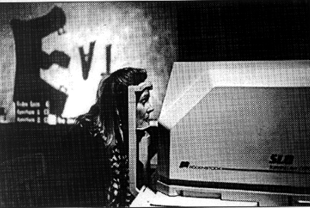
Into the Future : The Seeing Machine
and Accessing Architecture
the seeing machine | accesing architecture
The Seeing Machine
The Scanning Laser Opthalmascope, invented by Dr. Robert Webb, was designed
to test the fraction of healthy retina remaining in a person suffering
from retinal disease. It works by projecting an image past vision obstructing hemorrhages onto the healthy part of a viewer's retina (if any), thus enabling the viewer to see. Elizabeth Goldring is interested in the nonmedical application
of this machine for the visually impaired by enabling them to read
certain texts and to see visual poems, and, more recently, to experience
architecture.
Based on experiences with the SLO, we've built a cheaper, more portable
version in order to reach the public m ore effectively. We are testing this
verstion of the SLO, named "The Seeing Machine", with visual language perception
and architectural models, supported by a pilot study grant from NASA. The
ability to undesrstand the concept of space depends primarily on vision.
We hope that through our collaboration with NASA, the blind and visually
challenged will be able to participate in the space program in the future.
Accessing Architecture
Confronting unknown physical conditions particular to a new place
can be a source of anxiety for most of us. The option of a pre-glance or
pre-visit might go far in allaying a host of anxieties. Entering an architectural
space for the first time can be a source of terror, particularly for people
who are blind or visually compromised - are there steps; railings; what
lies on the other side of the door; around a corner; what unexpected obstacles;
where in the chaos of "brick and motar" or steel and glass is the destination
- the right office, etc. Not having answers to these basic questions can
result in extreme anxiety, loss of independence and undermine a sense of
well-being.
Some of these and other basic questions can only believably be answered
even for people who are visually compromised through spatial visual imaging.
On site braille "relief maps" , while better than nothing, do not adequately
relieve anxieties that may keep people from going to new places.
"Accessible Architecture" is a project that proposes to create virtual environment
walkthroughs of existing buildings, enabling people to to pre-visit them and become familiar with them, thus eliminating some of the anxiety
of experiencing an unfamiliar place. To accomplish this, The Seeing Machine
and the SLO will be used in conjunction with architectural models, created
in AutoCAD and then programmed with navigation and force-feedback capability.
In this way, the person walking "through" them can feel their way around
by pairing visual input with a virtual walking stick.


